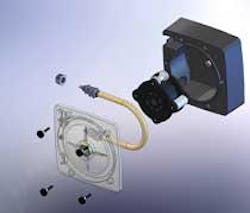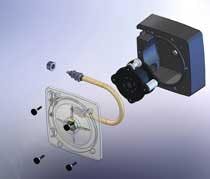Peristaltic Pumps Excel in Chloramine Application
Maintaining the correct amount of chlorine for effective drinking water system disinfection in a large municipal drinking water system can be challenging. Piping system lengths, variable flow rates and demands, and other factors contribute to the difficulties in maintaining the optimum level of free chlorine throughout the entire system.
One method of increasing the length of time that the chlorine remains effective in the system is to add ammonia. With the addition of ammonia, chloramines are formed resulting in not only a more stable and longer lasting disinfecting residual than free chlorine, but also the additional benefit of a reduction in the amount of initial chlorine injection required and a similar reduction in unpleasant chlorine odor and taste.
Although the mixing of ammonia with chlorine to form chloramines is a safe and effective means to treat drinking water, the addition of ammonia can create a potential hazard if the chlorine is not present. The proper chlorine/ammonia ratio must be maintained to form the chloramines. For this reason, system designers are careful to select the most reliable injection system components possible that also allow for variable flow rate requirements and permit continuous monitoring and remote control by SCADA systems.
Chuck Boone, the Mechanical Maintenance Supervisor at the Irvine Ranch Water District (IRWD) in Irvine, CA, became concerned about the new IRWD reservoir management system (RMS) pilot project when the diaphragm pumps chosen for the chlorine injection task repeatedly failed. Although sensors in the system detected the failure and safely shut down the system, it became obvious that a more reliable chlorine injection pump system was required.
The cause of the diaphragm pump failures was traced to the pumps losing prime due to vapor locking. Vapor locking is caused by gases escaping from the fluid and building up in the pump head preventing the valves from operating correctly. This phenomenon commonly occurs when the pump is sitting idle, such as at night or when the system demands are low. The IRWD maintenance mechanics worked with the diaphragm pump manufacturers to install de-gassing valves and other devices that would permit the pump to automatically expel the built up gasses from the pump head, but these measures were unsuccessful. Looking for a better way to inject chlorine, the IRWD team turned their focus to peristaltic pump technologies.
Commonly called “squeeze tube pumps,” the new generation of peristaltic pump is quite different from the low pressure, non-industrial peristaltic pumps most people are familiar with seeing in a hospital setting. These industrial pumps are now capable of long tube life and output pressures to 125 PSI. Some models also include such features as tube failure detection systems, flow verification sensors, heavy duty weatherproof enclosures and sophisticated electronics for connection to SCADA systems.
Peristaltic pumps use a circular pump “head” and simple rotating roller design to gently squeeze the fluid through a piece of specially designed tubing. With no valves to clog, metal springs to corrode or ball seats to fail they can effectively pump both fluids and gasses, eliminating the possibility of vapor locking and loss of prime. A peristaltic pump’s output is not affected by changes in the system pressure (it therefore does not have a pump output curve) making its output much more consistent than a diaphragm pump.
Selection Considerations
In a chloramine application, it is critical that the ammonia pump inject at a proportional rate with the chlorine pump and automatically deactivate in the event of a chlorine pump failure. The new generation of variable speed peristaltic pumps meets the requirements for both the chlorine and ammonia pumps in a chloramine application.
Manufacturers of these pumps include many of the features used by large municipal water treatment systems such as scalable 4-20mA (analog) and high speed pulse (digital) input and output signals. These I/Os not only permit the SCADA system complete control of both pumps but they can also provide solutions for external data logging, remote diagnostics and driving multiple pumps and devices from the primary pump.
The scalable analog output signal provided the IRWD team a simple method for proportionally driving the ammonia pump directly off of the chlorine pump.
Blue-White Industries will exhibit its Flex-Pro™ A3 Peristaltic Metering Pump at ACE '08. The pumps offer outputs to 33.3 gph, a 100:1 turndown ratio and continuous feed. With output pressure ratings to 125 psi and its ability to pump gases, they are suited for use in chlorine dosing applications.

